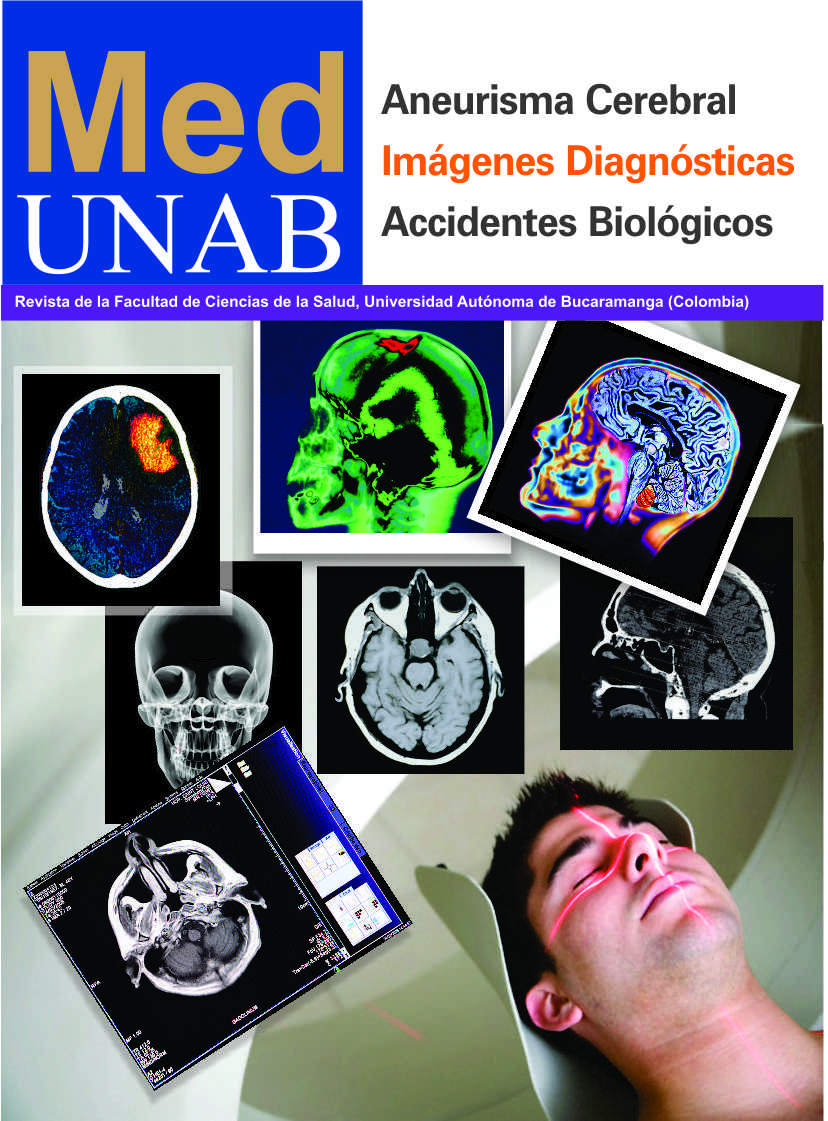Factores pronósticos de mortalidad por sepsis severa en unidades de cuidado crítico del área metropolitana de Bucaramanga
Resumen
Introducción La sepsis es la principal causa de mortalidad en unidades de cuidado crítico, factores de riesgo de mortalidad como la edad, el género y las escalas de severidad han sido estudiados. En nuestra población de estudio las otras complicaciones durante la hospitalización fueron las más relacionadas con el descenlace.
Materiales y métodos Estudio de cohorte de 150 pacientes admitidos a unidad de cuidado critico de cuatro unidades del área metropolitana de Bucaramanga, con diagnostico de sepsis severa o choque séptico fueron estudiados mediante un cuestionario sobre variables socio-económicas, clínicas y microbiológicas. Se realizó análisis bivariado con pruebas t de student y chi cuadrado. El análisis multivariado mediante regresión de cox con el tiempo al evento como variable de descenlace.
Resultados Los pacientes sobrevivientes tuvieron un promedio de edad de 64 años y los no sobrevivientes de 67 años, sin que se demostraran diferencias estadísticas entre los dos grupos de pacientes. No se encontraron diferencias en cuanto al género. El factor de riesgo más importante asociado a mortalidad por sepsis fueron las complicaciones durante la hospitalización, incluso luego de ajustar por el puntaje sofá inicial, el sitio de infección y los indicadores de respuesta inflamatoria como la hiperlactatemia e hiperbilirrubinemia.
Conclusiones Se encontraron tres modelos de riesgo para mortalidad por sepsis con otras complicaciones durante la hospitalización como el factor de riesgo más relevante y el control glicemico como el factor de protección más importante.
Referencias bibliográficas
Blanco J, Muriel-Bombín A, Sagredo V, Taboada F, Gandía F, Tamayo L, et al. Incidence, organ dysfunction and mortality in severe sepsis: a Spanish multicentre study. Critical Care, 2008; 12:R158.
Dougnac A, Mercado M, Cornejo R, Cariaga M, Hernández G, Andresen M. Prevalencia de sepsis grave en las Unidades de Cuidado Intensivo. Primer estudio nacional multicéntrico. Rev Méd Chile, 2007;135:620-30
Angus DC, Linde-Zwirble WT, Epidemiology of severe sepsis in the United States: analysis of incidence, outcome, and associated costs of care. Crit Car Med 2001; 29:1303-9.
Angus DC, Wax RS. Epidemiology of sepsis: an update. Crit Care Med 2001, 29:S109-S116.
Alberti C, Brun-Buisson C, Burchardi H, et al. Epidemiology of sepsis and infection in ICU patients from an international multicentre cohort study. Intens Care Med 2002; 28:108-21.
Jaimes F. Aliterature review of the epidemiology of sepsis in Latin America. J PanAm Public Health 2005; 18:163-71.
Levy MM, Fink MP, Marshall JC, Abraham E, Angus D, CookD,etal.2001SCCM/ESICM/ACCP/ATS/SISInternational Sepsis Definitions Conference. Crit Care Med 2003; 31:1250-6.
Angus DC, Walter T, Linde-Zwirble, et al. Epidemiology of severe sepsis in the United States: Analysis of incidence, outcome, and associated costs of care; J Crit Care Med 2001; 29:1303-10.
Bernal D, Garzón N. Eventos adversos durante la atención de enfermería en unidades de cuidado intensivo. Facultad de Enfermería. Especialización en Cuidado Crítico. Univer-sidad Pontificia Javeriana, 2008. (Disponible en: http:// www.javeriana.edu.co/ biblos/tesis/enfermeria/tesis44.pdf)
Gierek D, Kuczera M, Dabek J. Results of severe sepsis treatment-two years of experience in a single centre. Anestezjol Intens Ter 2011; 43:22-8.
Demertzis LM, Kollef MH. The resuscitation package in sepsis. Curr Infect Dis Rep 2010; 12:368-73.
Braber A, van Zanten AR. Unravelling post-ICU mortality: predictors and causes of death. Eur J Anaesthesiol 2010; 27:486-90.
Dreiher J, Almog Y, Sprung CL, Codish S, Klein M, Einav S, et al. Temporal trends in patient characteristics and survival of intensive care admissions with sepsis: Amulticenter analysis. Crit Care Med 2011; 40:855-60.
Esper A, Moss M, Lewis CA, Nisbet R, Mannino D, Martin GS. The role of infection and comorbidity: Factors that influence disparities in sepsis. Crit Care Med 2006; 34:2576-82.
Shiramizo SC, Marra AR, Durão MS, Paes ÂT, Edmond MB, Pavão dos Santos OF. Decreasing mortality in severe sepsis and septic shock patients by implementing a sepsis bundle in a hospital setting. PLoS One 2011; 6:e267-90.
Vincent JL, Sakr Y, Sprung C, Ranieri VM, R, et al. Sepsis in European intensive care units: Results of the SOAPstudy; J Crit Care Med 2006; 34:344-53.
Kauss IAM, Cintia MC, Grion M, et al. The epidemiology of sepsis in a Brazilian teaching hospital. Braz J Infec Dis, 2010;14:264-70.Alas instituciones de salud participantes.
Bouglé A, Duranteau J. Pathophysiology of sepsis-induced acute kidney injury: the role of global renal blood flow and renal vascular resistance. Contrib Nephrol 2011;174:89-97.
Matejovic M, Chvojka J, Radej J. Sepsis and acute kidney Universidad Autónoma de Bucaramanga, Convocatoria de injury are bidirectional. Contrib Nephrol 2011;174:78-88.investigaciones 2009-2010.
Molina FJ, Díaz CA. Perfil microbiológico de la Infecciones en Unidades de Cuidados Intensivos de Colombia (EPISEPSIS Colombia). Med Intensiv 2011; 35:75-83.
Dellinger RP, Levy MM, Carlet JM, Bion J, Parker MM, Jaeschke R, et al. Surviving Sepsis Campaign: international guidelines for management of severe sepsis and septic shock: 2008. Crit Care Med 2008;36:296-327.
Vincent JL. Acute kidney injury, acute lung injury and septic shock: how does mortality compare? Contrib Nephrol 2011;174:71-7.
Silva E, Pedro M, Sogayar AC, et al. Brazilian Sepsis Epidemiological Study Crit Care, 2004; 8:R251-60.
Descargas
Derechos de autor 2022 MedUNAB

Esta obra está bajo una licencia internacional Creative Commons Atribución-NoComercial 4.0.
| Estadísticas de artículo | |
|---|---|
| Vistas de resúmenes | |
| Vistas de PDF | |
| Descargas de PDF | |
| Vistas de HTML | |
| Otras vistas | |






























